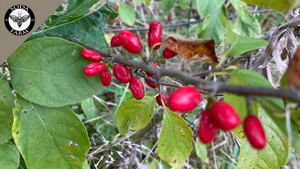Spicebush Berries Taste Like Allspice
I vividly remember the first time I encountered a spicebush (Lindera benzoin). I was a sophomore in college and I was in a taxonomy class that traveled around Ohio’s forests learning to identity its native trees. We had been deep inside the woods that day for several hours, but the canopy overhead had just begun to thin and I could see a meadow at the end of our path just a bit ahead. There were more shrubs here in between the trees as the forest transitioned into the clearing and my professor stepped off the path to stand beside one in particular. He introduced the shrub as spicebush and we all began to take notes on the bud shape, bark appearance and leaf venation. With my head down over my paper I barely noticed when he plucked a leaf, crumpling it up before he passed it to me, but as soon as I had it in my hand I was done writing. The spicy, lemon scent that jolted my senses seemed to wash my perception of the leaf covered forest floor around me in yellow. I was in love.
Spicebush For Pollinators
Spicebush has a lot to recommend it as a plant you might want to add to your landscape…. It is a primary food for the fascinating Spicebush Swallowtail… one of the cutest caterpillars on the planet! This caterpillar is a big part of why I planted spicebush on the farm!!

Are Spicebush Berries Edible?
We humans have loved spicebush for more personal reasons for a very long time. During the time of the great explorers, North America was an obstacle on the trade routes, not a destination… but hidden on the edge of its forests, settlers soon discovered that spicebush berries were a delicious and acceptable replacement to the tropical allspice!
As travel became easier, spices became more readily accessible from the East. Spicebush was forgotten once again. Today it is part of Slow Food’s Ark of Taste, and those who wish to preserve our food heritage are again bringing the delicious flavor of spicebush to the forefront of our plates. The shrub is featured in our Bliss Tea Blend and grows where those on a walking tour can pause and look for evidence of cool caterpillars.
What Is Spicebush Good For?
If you’re curious about how to grow spicebush, would like to know how the Cherokee used this plant for traditional healing, or are curious about the research being done today into how we use this shrub for health give my membership a FREE 7 day trial!
A Recipe
A few years back I wrote an article on the Spicebush for Heirloom Gardener (a Mother Earth News Living sister publication) magazine. Here is one of the recipes I shared:
Fever Chai
(Makes 5-7 cups of tea)
- 1/2 star anise
- 8 whole cloves
- 8 spicebush berries
- 2 sticks cinnamon (smashed)
- 1 cardamom pod
- 7 twigs spicebush (broken to equal about 2 ounces)
- 1 Tbsp fresh sliced ginger
- 2 cups water
Before placing the ingredients into a saucepot, crush them lightly with a mortar and pestle. Cover the spices with water and bring to a boil. Reduce heat to simmer for 30 minutes or until the water has reduced by half.
- 4-6 cups milk (almond milk makes a nice substitute)
- 2 Tbsp black tea
- Sugar or honey to taste
Add the milk to the pot and bring back almost to a boil. Remove from heat. Add the black tea, cover and steep for 5 minutes. Strain. While still warm, add sugar honey to taste and then use a milk frother to whip your chai. Serve immediately. *This can be made without the milk if preferred.

